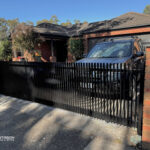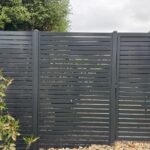
When considering installing a wood fence, one important question that often arises is the lifespan of such a fence. Understanding how long a wood fence lifespan is crucial for making informed decisions about materials, maintenance, and overall investment. Factors such as wood type, quality, climate, maintenance, and installation techniques can all influence the wood fence lifespan. By exploring these variables, we can gain valuable insights into the expected of a wood fence lifespan and make informed choices when planning for fencing needs.
Why Wood Fences Are Chosen by Many People
Wood fencing is a popular choice among many individuals seeking to enhance the aesthetics of their property. Its natural and classic appearance adds a touch of beauty to any landscape. Wood fences offer versatility, as they come in various styles and heights, catering to different needs such as privacy, security, and decorative purposes.
The customizable nature of wood allows homeowners to create personalized designs that suit their preferences and complement the overall style of their property. Furthermore, wood is an environmentally friendly option, appealing to those who prioritize sustainability. While wood fencing may require regular maintenance, such as staining and sealing, to protect against weathering and potential damage, its cost-effectiveness and timeless appeal make it a favored option for creating functional and visually appealing barriers around properties.
Read more: 10 Factors to Consider When Choosing Timber Fencing
Factors Affecting Wood Fence Lifespan
Types of Wood Used
The choice of wood species significantly impacts a fence’s durability. Some types of wood, like cedar and redwood, are naturally more resistant to decay, insects, and rot due to their natural oils and resins. Others, like pine, may be more susceptible to damage and decay. Choosing a wood species with natural resistance or using pressure-treated wood can enhance the fence’s longevity.
Quality of Wood
Even within the same wood species, the quality of the wood can vary. Higher-grade, well-milled wood with fewer knots and defects tends to last longer than lower-grade or flawed wood.
Climate and Environmental Factors
The climate and environmental conditions play a significant role in a wood fence lifespan. In wet and humid climates, the fence is more prone to moisture-related issues like rot and mold. In arid or sunny regions, prolonged exposure to sunlight can lead to wood drying and cracking. Adapting the fence design and using appropriate sealants or coatings can help mitigate the effects of harsh weather conditions.
Maintenance and Care
Regular maintenance and care are crucial for extending the wood fence lifespan. This includes cleaning the fence to remove dirt and debris, inspecting for any signs of damage or wear, and applying protective finishes like stains or sealants. Proper maintenance helps prevent moisture absorption, wood decay, and insect infestations.
Proximity to Soil and Vegetation
Wood fences that are in close contact with soil or surrounded by vegetation are at higher risk of moisture absorption and rot. Ensuring proper drainage, maintaining a gap between the fence and the ground, and addressing any vegetation growth near the fence can help prolong its lifespan.
Overall, by considering the type of wood, its quality, proper installation techniques, climate adaptation, regular maintenance, and addressing usage and environmental factors, homeowners can maximize the longevity of their wood fences. Taking these factors into account allows for informed decision-making and ensures that the fence remains a durable and attractive addition to the property for years to come.
Read more: How Much Does Timber Fencing Cost in 2024
How Long a Wood Fence Lifespan?

The lifespan of a wood fence can vary significantly, typically ranging from 15 to 30 years. This variation is influenced by several key factors, including the type of wood used, the level of treatment, the climate, and the maintenance practices employed.
Wood Type: The type of wood you choose for your fence plays a crucial role in determining its longevity. Hardwoods such as cedar, redwood, and teak are known for their durability and resistance to decay. These woods can endure harsh conditions and typically last between 20 to 30 years. On the other hand, softer woods like pine, though more affordable, generally have a shorter lifespan, ranging from 15 to 20 years. The inherent properties of hardwoods make them more resilient to insects, moisture, and physical wear, which contributes to their extended service life.
Treatment: Wood treatment is another critical factor in extending the lifespan of a fence. Pressure-treated wood is infused with preservatives that enhance its resistance to rot, insects, and decay. This treatment process significantly prolongs the life of the wood, often making it last longer than untreated wood. The added protection against environmental factors and pests helps ensure that the fence maintains its structural integrity over time.
Climate: The local climate can have a profound impact on the durability of a wood fence. Harsh weather conditions, such as heavy rainfall, high humidity, or extreme temperatures, can accelerate wear and tear. Regions with frequent rain may see faster deterioration due to increased moisture exposure, which can lead to rot and mold. Conversely, areas with extreme heat and UV exposure can cause the wood to dry out, crack, and become brittle. Understanding your local climate and selecting wood and treatments accordingly can help mitigate these effects.
Maintenance: Regular maintenance is essential for prolonging the lifespan of a wood fence. Routine tasks such as sealing, staining, or painting protect the wood from moisture, UV rays, and insects. Sealing the wood creates a barrier against water infiltration, which helps prevent rot and decay. Staining or painting adds an additional layer of protection and can enhance the aesthetic appeal of the fence. Without proper maintenance, wood fences are more susceptible to damage and deterioration, reducing their overall lifespan.
By selecting high-quality wood, using appropriate treatments, accounting for climate conditions, and committing to regular maintenance, a wood fence can provide reliable service and aesthetic value for decades. With proper care, your wood fence will not only stand the test of time but also continue to enhance your property for many years to come.
Conclusion
In conclusion, the wood fence lifespan typically ranges from 15 to 20 years, although this can vary depending on several factors. Choosing the right type of wood, such as cedar or redwood, or opting for pressure-treated wood can significantly extend the fence’s durability by enhancing its resistance to decay, moisture, insects, and other environmental factors.
While vinyl and metal fences generally have longer lifespans, proper maintenance and care can help protect wood fences and ensure their longevity. Applying a water-repellent coating, promptly addressing damage, and monitoring for signs of deterioration can prevent issues caused by moisture and prolong the fence’s lifespan.
If you are in search of the perfect fence that suits your budget, we recommend reaching out to Pentagon Fencing & Gates for comprehensive information on their wide range of fences and gates. They can assist you in finding the ideal fencing solution that aligns with your budgetary requirements. Don’t hesitate to contact 0424 204 857 or via email: info@pentagonfencing.com.au to explore your options and make an informed decision for your fencing needs.





